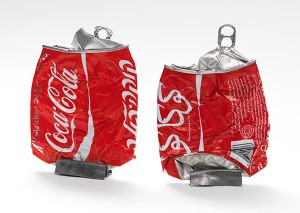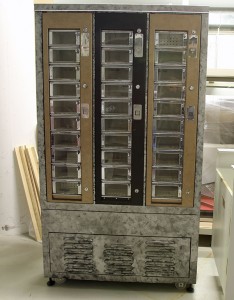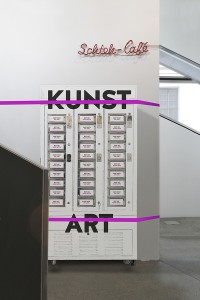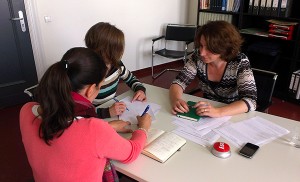A Conversation with Andrei Krioukov

Artistically-treated Coca-cola cans
© Jewish Museum Berlin, photo: Jens Ziehe
As a contribution to our art vending machine, Andrei Krioukov treated and crushed Coca-Cola cans with Hebrew and Arabic labels. I met him and his wife Rita at their art school on Immanuelkirchstraße in Berlin. This is where Andrei teaches international students, who both study and take their state-recognized exams with him.
In our discussion Andrei talks about his fascination with the design of the famous cans and explains the elements of both trash and art they represent.
Christiane Bauer: Andrei, what fascinates you about the Coca-Cola can?
Andrei Krioukov: These cans are typical of our lives today. You can find them everywhere, but hardly anyone notices them. For me, the discrepancy between art and trash is an exciting subject: if a can is lying on the street, it’s trash. But if I pick it up and contemplate it, and I ponder what I can do with it, it turns into art.
An artist from the 19th century could paint garlic, an onion, or a pitcher of water. Today our lives are full of Coca-Cola cans.
The pitcher appeared in still life paintings as an object from everyday life. What significance does the can have? Do you see a can of Coke as a disposable article or as a modern cultural artifact? → continue reading

This is what the vending machine looked like originally.
© Jewish Museum Berlin, photo: Gelia Eisert
Usually a museum is a place where you can contemplate art from a safe distance. Today, with the mounting of our Art Vending Machine in our permanent exhibition, that will change: now you can put 4 euros in the coin slot, and own a piece of art from the museum!
If you’re imagining a high-tech machine that produces art, when you read the words “Art Vending Machine,” or something like a soda machine, where you can pick and choose from a selection, you’re on the wrong track. Our Art Vending Machine has a supply of small-scale artworks that were created by artists especially for it.
Since a device of this kind isn’t commercially available, I bid online for an old vending machine from the 1970s. I found one in a sports center in the Rhineland-Palatinate region of Germany and had it transported to us from there.

After its modification, the vending machine should look like this.
© Design: Hanno Dannenfeldt
Following the machine’s arrival, the graphic designer Hanno Dannenfeldt worked on a concept for reconfiguring it, since it’s meant to be not only a container for artworks tucked into all the little shelves, but itself part of the exhibition. The design, called “Hanging,” dresses the automat in a simple white coat of paint with an eye-catching black inscription. It’s strung up on the wall with pink slackline cables.
The next steps of this procedure raised some unusual questions for me as a museum employee: → continue reading
The Blog’s Editorial Staff in Discussion (Part II)

Meeting of the website editors
© Jewish Museum Berlin, photo: Michael Butschkau
Naomi Lubrich: We recently talked together about Eva Menasse’s novel Quasicrystals but we haven’t decided which of us will write a review of the book for our blog. Personally I would be interested in doing it, and I have something to say not only about the Jewish theme but also about Menasse’s image of women, that I found to be unrealistically and ideationally drawn. Xane is a downright caricature of a “high-powered woman”: a caring mother and stepmother of three children with, to some extent, behavioral problems. And at the same time she’s a leading film artist and influential intellectual. On top of all this she has a harmonious, uncomplicated marriage, and she even gets involved with a number of other men… → continue reading



